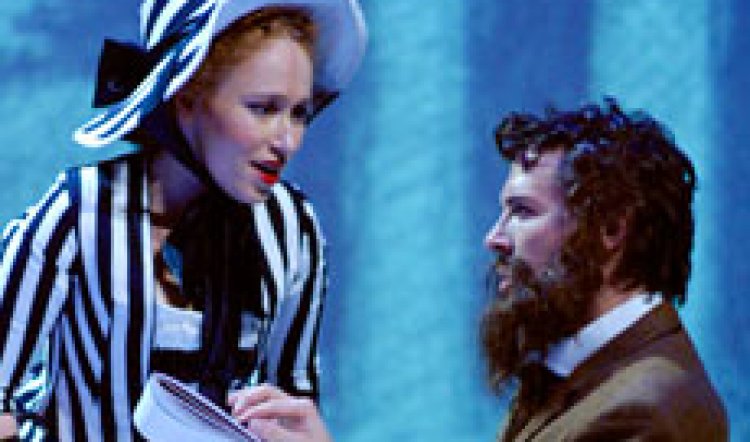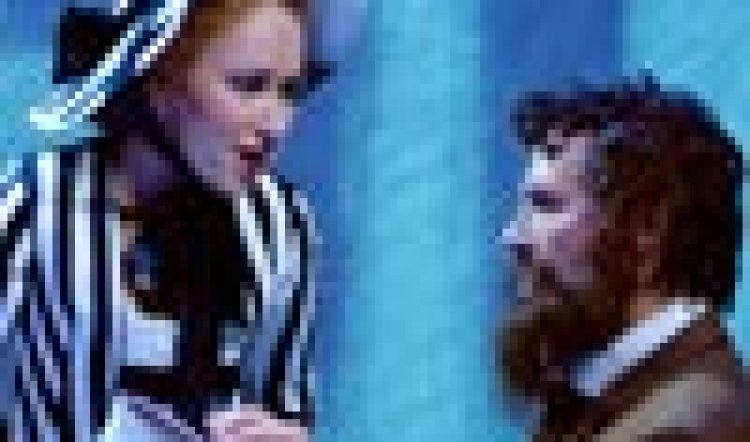
Sunday in the Park with George
Although the Stephen Sondheim-James Lapine mini-masterpiece was first seen in New York in 1985 and won the Pulitzer Prize for Drama, it's now - two decades on- that its time has come. This is because a show which is essentially about the shifting nature of art and, in particular, Georges Seurat's innovation of pointillism (or chromolumism as he called it) can be brought to vivid, pulsating life on stage via digital technology.
The Q Theatre Company deserves a barrowload of bouquets for having the nerve and imagination to stage this production. It's not an easy piece, it's not cheap and it isn't an obvious crowd-pleaser or box office winner: Sondheim? Shudder! Art? Shivers! High concept? Gasp! Musical with a cast of French nobodies? Horrors! So to take the plunge and to do it with such panache and skill is little short of dazzling.
Sunday in the Park was inspired by Seurat's "Sunday Afternoon on the Island of La Grande Jatte." (Domiciled these days at the Art Institute of Chicago if you want to look at the real thing and at www.artic.edu/artaccess/AA_Impressionist/pages/IMP_7.shtml for a quick look and more about the huge - 2x3m canvas.) At James Lapine's urging, Stephen Sondheim began to think about who the inhabitants of the picture might have been and then, what were their stories? Between them they brought these nameless Parisians to life.
The central characters are George the artist - and his model-muse-girfriend Dot, played and sung with charm and conviction by Tyran Parke and Amie McKenna. They are well supported by Laurence Coy, Trisha Crowe, Phillip Dodd, Natalie Gamsu, Luke Joslin, Barry Langrishe, Drayton Morley, Jennifer Peers and Buster Skeggs as the members of the bourgeoisie - haute and petit - who made up the summer afternoon strollers on the island in the Seine. Like Seurat himself, George spends his waking hours obsessively sketching and working up the composition, to the detriment of his health and his relationship with flesh and blood humans, including Dot who finally leaves him despite being pregnant with his child.
[page]The excitement and unease of the era are present in Sondheim's music - simultaneously modernist and lyrical - and the characters. In Paris of the mid-1880s tradition was crashing hard into rapidly accelerating industrialisation. Seurat's painting and this semi-operatic musical are full of references to that upheaval in society. The site of the work - the sylvan setting of the river island's park - was already being encroached upon by the spreading city, the coming Exposition and its most famous symbol, the Eiffel Tower (opened with great fanfare in 1889, three years after Seurat's painting was controversially unveiled). While the argument about the nature of Art brings the first act to a witty close.
The second half is a change of scene and pace and was added to make the piece full length. The action zooms forward to the present day where the arguments about art continue - but on a more pretentious level and much more about how to make money and collect collectors. George - minus his post-Impressionist beard and now the artist's fictional great-grandson - is still not very good at human relationships and still plausibly charming, while the women in his life have become even more complicated.
If a parallel universe is really about the nature of the brain (we don't really live in the present because our brains are usually anywhere but) then Sunday in the Park with George makes perfect sense of anything that has ever happened to anybody - emotionally, physically and metaphysically. Otherwise, it's about colour, light, sound and ideas and the surreal nature of the human condition. Either way, it's absorbing and more entertaining than a cartload of the monkeys seen in the right foreground of the painting. And much more about art than the modern George's neon "chromolumes" - but ain't that the nature of conceptual art anyway?

 The production design by David Hollywood may well figure in the 2007 Sydney Theatre Awards shortlist: it's brilliant as it starts out in monochrome sketches, picks up increasing amounts of pointillist colour and ends in ghostly white. Joshua Mason's costume designs add the final layer of interest and almost-authenticity, Andrew Kinch's lighting is the third visual dimension in a satisfying whole. Musical director Greg Crease and the band are invisible - a shame for them, because they're very good.
The production design by David Hollywood may well figure in the 2007 Sydney Theatre Awards shortlist: it's brilliant as it starts out in monochrome sketches, picks up increasing amounts of pointillist colour and ends in ghostly white. Joshua Mason's costume designs add the final layer of interest and almost-authenticity, Andrew Kinch's lighting is the third visual dimension in a satisfying whole. Musical director Greg Crease and the band are invisible - a shame for them, because they're very good.
The only real criticism is one that has nothing to do with the production: the gruesome state of ventilation. The theatre has now been open 18 months and it's about time somebody undertook to get the aircon right. On opening night it was 28C in the auditorium and despite the fabulous production, many in the audience were virtually comatose by the interval. This is not an isolated occasion and it makes life difficult for everyone concerned. It needs to be fixed.
Sunday in the Park with George, Q Theatre, Penrith to March 31; ph: 4723 7600 or www.ticketmaster.com.au
You can hear an interview with Tyran Parke about his preparation to play George in episode 14 of Stagecast.



